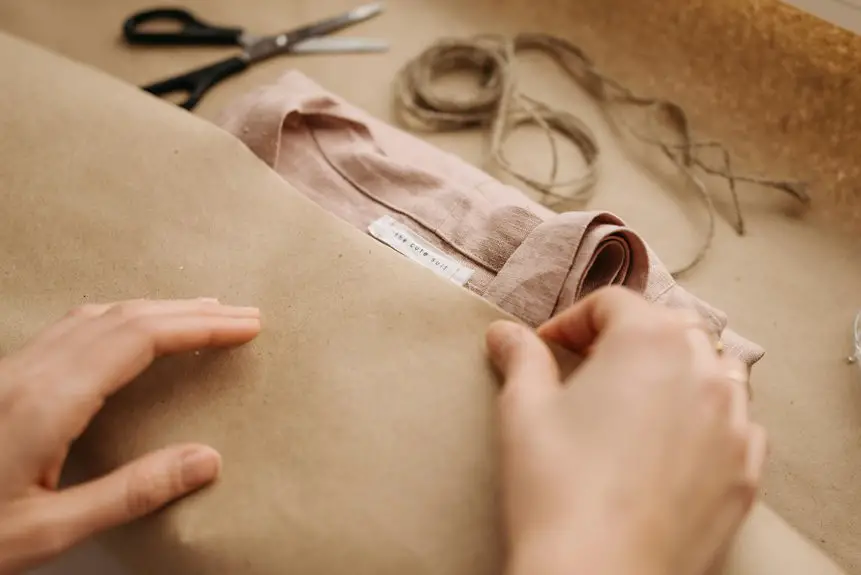To care for your 100% acetate garment, always wash it in cold water using a mild detergent and a gentle cycle to avoid shrinkage and damage. Skip the dryer—air dry by laying it flat or hanging in shade, away from direct sunlight. When ironing, use the lowest heat setting, a pressing cloth, and iron inside out. Handle stains gently and avoid scrubbing. Stick to these tips to keep your garment soft and looking new, and discover how else to protect its texture and color.
Table of Contents
Key Takeaways
- Wash acetate garments in cold water with mild detergent on a delicate cycle to prevent shrinking and damage.
- Air dry by laying flat or hanging in shade; avoid machine drying and direct sunlight to preserve fabric strength.
- Iron inside out on the lowest synthetic setting using a pressing cloth, and avoid direct steam to protect fibers.
- Handle stains gently, avoid scrubbing, and seek professional cleaning for stubborn marks to prevent fabric damage.
- Store on padded hangers in a cool, dry place with breathable garment bags to maintain shape and prevent creasing.
Understanding the Properties of Acetate Fabric
Although acetate fabric looks and feels like silk, it’s actually a synthetic fiber made from cellulose. When you wear acetate, you get the smooth, shiny appearance similar to silk but with added durability.
You should know that acetate has great drape and resists shrinking, making it ideal for elegant garments. However, it’s sensitive to heat and can easily melt or get damaged if exposed to high temperatures.
It also tends to wrinkle easily, so you’ll want to handle it gently. Another key point: acetate can be prone to water spots and may lose strength when wet.
Understanding these properties helps you treat acetate garments with the care they need, preserving their luxurious look and feel over time.
Washing Guidelines for 100% Acetate Garments
When washing 100% acetate garments, you’ll want to use cold water to prevent shrinking or damage.
Choose a mild detergent that’s gentle on delicate fabrics to maintain the fabric’s sheen and texture.
Avoid harsh chemicals that can break down acetate fibers over time.
Water Temperature Tips
Since acetate fibers are sensitive to heat, you should always use cold or lukewarm water when washing your 100% acetate garments to prevent shrinking or damage.
Hot water can weaken the fibers and cause colors to fade or bleed. Lukewarm water, ideally below 30°C (86°F), gently cleans without stressing the fabric.
When hand washing, fill a basin with cold or lukewarm water and avoid sudden temperature changes, as they can cause the fabric to distort.
If you use a washing machine, select a delicate cycle with cold water.
Remember, sticking to the right water temperature preserves your garment’s shape, texture, and brightness longer.
Detergent Selection Advice
Choosing the right detergent plays a big role in protecting your acetate garments during washing. You want to pick a gentle, mild detergent that’s free of harsh chemicals and enzymes, which can damage the delicate fibers.
Look for detergents labeled as “for delicates” or “gentle wash.” Avoid bleach and fabric softeners, as these can weaken acetate and affect its sheen.
When washing by hand or machine, use only a small amount of detergent to prevent residue buildup. If you’re unsure, opt for a detergent specifically designed for synthetic fabrics.
Best Drying Practices to Avoid Damage
Although acetate garments can feel delicate, you can protect their shape and sheen by drying them carefully. Avoid high heat and rough handling to prevent shrinking, warping, or dullness. Instead, air drying is your best bet.
| Drying Method | Recommended Action |
|---|---|
| Machine Drying | Avoid entirely; heat damages fiber |
| Air Drying | Lay flat or hang in shade |
| Direct Sunlight | Avoid; causes fading and weakening |
| Tumble Dry Low Setting | Not recommended |
After washing, gently squeeze out excess water—don’t wring. Lay your acetate garment flat on a clean towel or hang it on a padded hanger indoors. This helps maintain its structure and keeps the fabric looking fresh without risking damage from heat or stretching.
Ironing and Steaming Tips for Acetate
Ironing acetate requires careful attention to avoid melting or damaging the fabric. Always set your iron to the lowest heat setting, often labeled “synthetic” or “acetate.”
Before ironing, turn the garment inside out to protect its shiny surface. Use a pressing cloth between the iron and the fabric to prevent direct contact.
Turn garments inside out and use a pressing cloth to shield acetate’s delicate surface while ironing.
Avoid using steam directly on acetate, as excess moisture combined with heat can cause wrinkles to set permanently. Instead, hold a steamer a few inches away and let the gentle mist relax the fibers.
If you don’t have a steamer, hang the garment in a steamy bathroom to loosen wrinkles naturally.
Always test a small, hidden area first to verify your method won’t harm the fabric.
How to Remove Stains From Acetate Fabric
When you spot a stain on your acetate garment, it helps to know the most common types like oil, ink, or food.
You’ll want to act quickly using the right stain removal techniques to prevent damage.
Let’s explore how to tackle these stains safely and effectively.
Common Stain Types
Stains on acetate fabric can be tricky, but knowing the type of stain you’re dealing with makes removal much easier.
Common stains include oil-based ones like makeup, grease, and lotions, which tend to cling stubbornly to acetate’s smooth fibers.
Water-based stains such as coffee, juice, or sweat are another frequent issue, often causing discoloration if not treated quickly.
Protein stains from blood or food can also appear, requiring careful attention to avoid setting.
Ink and dye stains are particularly challenging due to their strong pigments.
Finally, dirt and mud can embed in acetate’s texture, needing prompt action to prevent permanent marks.
Recognizing these stain types helps you choose the right approach to keep your acetate garment looking fresh and clean.
Stain Removal Techniques
Because acetate fabric requires gentle care, you’ll want to treat stains carefully to avoid damage.
Start by blotting the stain gently with a clean cloth—never rub, as that can spread or set the stain. Use cool water and a mild detergent to spot clean, avoiding hot water which can warp acetate fibers.
For stubborn stains, a mixture of water and white vinegar can help lift residue without harming the fabric. Always test any cleaning solution on a hidden area first.
After treatment, let the garment air dry flat to maintain its shape.
- Blot stains immediately with a clean, dry cloth
- Use cool water and mild detergent for spot cleaning
- Avoid rubbing or scrubbing the fabric
- Try a vinegar-water solution for tough stains
- Air dry the garment flat away from direct heat or sunlight
Storing Your Acetate Clothing Properly
Although acetate fabrics are delicate, you can keep your garments looking fresh by storing them correctly.
Always hang acetate clothing on padded or wide hangers to maintain their shape and avoid stretching. Avoid wire hangers, which can cause creases or damage the fabric.
Keep your acetate pieces in a cool, dry place, away from direct sunlight to prevent fading and deterioration. Use breathable garment bags instead of plastic ones to allow air circulation and reduce moisture buildup.
If you fold acetate garments, place tissue paper between folds to minimize creasing. Regularly check stored items for any signs of mildew or pests.
Avoiding Common Mistakes When Caring for Acetate
Proper storage plays a big role in keeping your acetate garments in top shape, but care doesn’t stop there.
Avoid common mistakes that can damage your clothes or shorten their lifespan. For example, don’t expose acetate to high heat or harsh chemicals, as they can weaken fibers and cause discoloration.
Also, avoid wringing or twisting your garment when wet to prevent permanent creases or stretching.
Keep these tips in mind:
- Don’t use bleach or strong detergents
- Avoid ironing on high heat; use a low setting or steam
- Don’t tumble dry; air dry flat or hang carefully
- Avoid prolonged exposure to direct sunlight
- Don’t store acetate in plastic bags, which trap moisture
Following these simple steps helps your acetate look fresh and last longer.
When to Take Your Acetate Garment to a Professional Cleaner
When should you take your acetate garment to a professional cleaner? If your garment has stubborn stains, intricate designs, or delicate seams, it’s best to leave it to the experts. Also, if the care label recommends dry cleaning, don’t ignore it. Professional cleaners know how to handle acetate without damaging its texture or sheen.
| Situation | Why Choose a Professional? | What to Expect |
|---|---|---|
| Stubborn stains | Specialized stain removal | Effective cleaning without damage |
| Intricate designs | Gentle, precise handling | Preserves details and fabric |
| Care label says dry clean | Guarantees proper cleaning method | Avoids shrinking or warping |
| Delicate seams | Prevents fabric stress | Maintains garment shape |
Maintaining the Color and Texture Over Time
To keep your acetate garment looking vibrant and feeling smooth, you’ll need to protect it from factors that cause fading and texture loss. Acetate is sensitive to sunlight, heat, and harsh chemicals, so handling it carefully is key.
Here’s how to maintain its color and texture over time:
- Store your garment away from direct sunlight to prevent fading.
- Avoid high heat when ironing; use a low setting with a pressing cloth.
- Keep away from bleach and strong detergents that can damage fibers.
- Air out after wearing to reduce moisture buildup and odors.
- Handle stains promptly with gentle spot cleaning to avoid permanent marks.
Frequently Asked Questions
Can Acetate Fabric Be Recycled or Is It Biodegradable?
Oh sure, just toss your acetate fabric into a magical recycling bin—if only! It’s not easily recyclable, and while it’s technically biodegradable, it takes ages. So, don’t expect it to vanish overnight, okay?
Is Acetate Fabric Hypoallergenic and Safe for Sensitive Skin?
Acetate fabric is generally hypoallergenic and safe for sensitive skin, so you shouldn’t experience irritation. However, if you have extreme sensitivities, it’s wise to test a small area first before wearing it extensively.
How Does Acetate Compare to Polyester in Terms of Durability?
You’ll find acetate less durable than polyester—it’s more prone to wrinkles and damage from heat. Polyester, on the other hand, resists wear and stains better, making it a tougher choice for long-lasting garments.
Can Acetate Garments Be Safely Worn in Hot, Humid Climates?
Wearing acetate in hot, humid climates is like dancing with a delicate breeze—it breathes somewhat but can cling and wrinkle easily. You’ll want to stay cool and dry since it’s less forgiving than synthetic fabrics.
What Are Common Fashion Uses for Acetate Besides Clothing?
You’ll find acetate used in linings, ribbons, and scarves because of its silky feel. It’s also popular in accessories like hats and handbags, adding a smooth, shiny finish that complements many fashion items beautifully.
- From Plant to Pulp: The Complete Abaca Fiber Processing Journey - June 25, 2025
- How Abaca Fiber Is Made: a Step-By-Step Extraction Process Guide - June 25, 2025
- Abaca vs. Hemp Fibers: A Head-to-Head Comparison for 2024 - June 25, 2025







